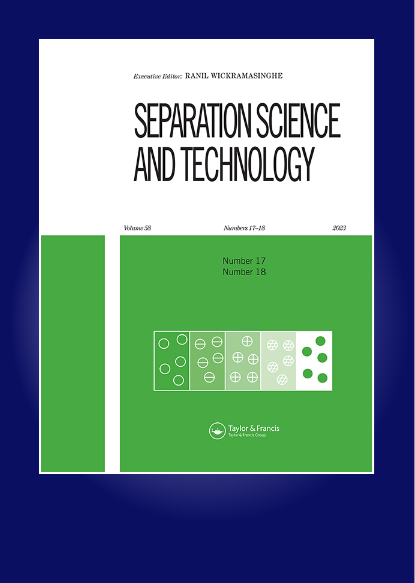废水中磺酸盐染料的络合萃取及染料结构对萃取性能的影响
IF 2.3
4区 工程技术
Q3 CHEMISTRY, MULTIDISCIPLINARY
引用次数: 0
摘要
摘要本研究考察了磺酸盐染料结构对萃取率、反应机理及络合比的影响。硫酸盐染料的母体结构和磺酸基数对萃取性能影响较大,而分子量对萃取性能影响较小。结果表明:在水-有机比为7:1时,偶氮染料的提取率保持在80%以上,而两种蒽醌染料的提取率分别降至54.9%和34.9%;在萃取剂不足的情况下,染料的磺酸基数越少,萃取性能越好,直接灰D和酸性红M的萃取率均在82%以上。用分配系数法确定了一套完整的萃取剂与染料配比的测定方法。Telon Yellow 4r与三辛胺的相互作用为离子缔合和氢键缔合,染料与萃取剂的络合比约为2:1。综上所述,染料结构对萃取性能影响较大,在实际应用中应加以考虑。本文章由计算机程序翻译,如有差异,请以英文原文为准。
Complex extraction of sulfonate dyes from wastewater and the effect of dye structure on extraction performance
ABSTRACT In this study, the influences of sulfonate dye structure on the extraction rate, the reaction mechanism, and the complex ratio were studied. The parent structure and the number of sulfonic acid groups of sulfonate dyes have a great effect on extraction performance, whilst the molecular weight has a small effect on extraction performance. The results indicate that the extraction rate of azo dyes remains above 80% at the aqueous-organic phase ratio of 7:1, but the extraction rate of two anthraquinone dyes decreases to 54.9% and 34.9%, respectively; and the fewer the number of sulfonic acid groups of the dye, the better the extraction performance under the condition of insufficient extractant, the extraction rate of Direct Grey D and Acid Red M is over 82%. A complete set of methods for determining the ratio of the extractant and the dye was determined using the distribution coefficient method. The interaction between Telon Yellow 4 R and trioctylamine is ionic association and hydrogen bonding association, and the complex ratio between the dye and the extractant is about 2:1. In summary, dye structure has a big impact on the extraction performance, which should be taken into account in actual application.
求助全文
通过发布文献求助,成功后即可免费获取论文全文。
去求助
来源期刊

Separation Science and Technology
工程技术-工程:化工
CiteScore
6.10
自引率
3.60%
发文量
131
审稿时长
5.7 months
期刊介绍:
This international journal deals with fundamental and applied aspects of separation processes related to a number of fields. A wide range of topics are covered in the journal including adsorption, membranes, extraction, distillation, absorption, centrifugation, crystallization, precipitation, reactive separations, hybrid processes, continuous separations, carbon capture, flocculation and magnetic separations. The journal focuses on state of the art preparative separations and theoretical contributions to the field of separation science. Applications include environmental, energy, water, and biotechnology. The journal does not publish analytical separation papers unless they contain new fundamental contributions to the field of separation science.
 求助内容:
求助内容: 应助结果提醒方式:
应助结果提醒方式:


